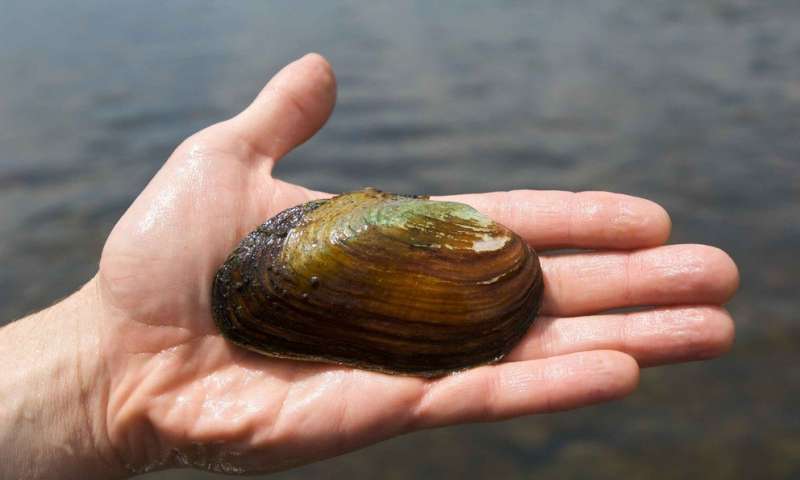

Photo: The Elliptio complanate freshwater mussel, one of the two species used in the experiment. Credit: Westcott Phillip
Elevated concentrations of strontium, an element associated with oil and gas wastewaters, have accumulated in the shells of freshwater mussels downstream from fracking wastewater disposal sites, according to researchers from Penn State and Union College.
"Freshwater mussels filter water and when they grow a hard shell, the shell material records some of the water quality with time," said Nathaniel Warner, assistant professor of environmental engineering at Penn State. "Like tree rings, you can count back the seasons and the years in their shell and get a good idea of the quality and chemical composition of the water during specific periods of time."
In 2011, it was discovered that despite treatment, water and sediment downstream from fracking wastewater disposal sites still contained fracking chemicals and had become radioactive.
In turn, drinking water was contaminated and aquatic life, such as the freshwater mussel, was dying. In response, Pennsylvania requested that wastewater treatment plants not treat and release water from unconventional oil and gas drilling, such as the Marcellus shale. As a result, the industry turned to recycling most of its wastewater. However, researchers are still uncovering the long-lasting effects, especially during the three-year boom between 2008 and 2011, when more than 2.9 billion liters of wastewater were released into Pennsylvania’s waterways.
“Freshwater pollution is a major concern for both ecological and human health,” said David Gillikin, professor of geology at Union College and co-author on the study. “Developing ways to retroactively document this pollution is important to shed light on what’s happening in our streams.”
The researchers began by collecting freshwater mussels from the Alleghany River, both 100 meters (328 feet) upstream and 1 to 2 kilometers (0.6 to 1.2 miles) downstream of […]
Full article: Fracking wastewater accumulation found in freshwater mussels’ shells
EPA researching freshwater mussels as biofilters in PA, MD and WV
Duke Study: Rivers Contaminated With Radium and Lead From Thousands of Fracking Wastewater Spills
Oil and gas wastewater radioactivity persists in Pennsylvania stream sediments
Report: over half PA gas wells used ‘secret’ chemicals for fracking or drilling
Penn State study: Spraying brine from drilling, fracking on roadways is hazardous
Clean water is essential for life, yet millions of Americans unknowingly consume contaminants through their…
Human brains contain higher concentrations of microplastics than other organs, according to a new study, and the…
From the Office of the Governor: In anticipation of a multi-day, significant atmospheric river in Northern California,…
From Governor Newsom: Scientists, water managers, state leaders, and experts throughout the state are calling…
Photo: A harmful algal bloom in Milford Lake, Kansas, made the water appear bright green.…
An expanded plastic foam coffee cup is at a donut shop in Monterey Park, California.…